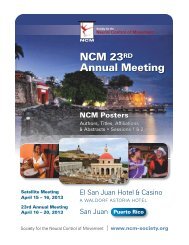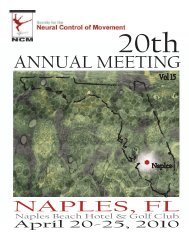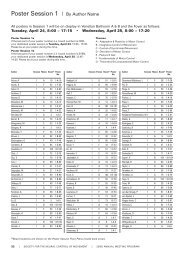2012 Program - Society for the Neural Control of Movement
2012 Program - Society for the Neural Control of Movement
2012 Program - Society for the Neural Control of Movement
Create successful ePaper yourself
Turn your PDF publications into a flip-book with our unique Google optimized e-Paper software.
2-A-20 Dominant arm is not always dominant: A<br />
hidden excellence <strong>of</strong> non-dominant arm in adapting<br />
to dynamical environments resulting from<br />
contralateral arm movement<br />
Atsushi Yokoi 1, Masaya Hirashima 1, Daichi Nozaki 1<br />
1Graduate School <strong>of</strong> Education, The University <strong>of</strong> Tokyo<br />
2-A-21 Partial learning <strong>of</strong> object dynamics based on<br />
fingertip <strong>for</strong>ces in <strong>the</strong> absence <strong>of</strong> kinematic errors<br />
Frederic Danion1, Jonathan S Diamond2, Randy J Flanagan2 1Universite de la Mediterranee, 2Queens University<br />
2-A-22 Cerebellar modulation <strong>of</strong> human associative<br />
plasticity<br />
Masashi Hamada1, Nagako Murase1, Anna Sadnicka1, Joseph M<br />
Galea1, Mark J Edwards1, John C Rothwell1 1UCL Institute <strong>of</strong> Neurology<br />
2-A-23 Cortical plasticity in elite athletes: Lessons<br />
<strong>for</strong> brain injury rehabilitation<br />
Damon Hoad1, Lekshmi Desikan1, Poppy Flanagan1, Sam Shribman1, Paul Hammond1, Richard Greenwood1, John Rothwell1 1Institute <strong>of</strong> Neurology<br />
2-A-24 Role <strong>of</strong> reuniens-medial prefrontal cortex<br />
and reuniens-hippocampal CA1 pathways in<br />
associative learning<br />
Juan Carlos López Ramos1, Lyndell Eleore1, Rafael Guerra-Narbona1, José María Delgado-García1 1Universidad Pablo de Olavide<br />
2-A-25 Analysis in individual differences in learning<br />
curves reveals greater variability <strong>for</strong> short timescale<br />
motor adaptation<br />
Yohsuke Miyamoto1, Maurice A Smith1 1Harvard University<br />
2-A-26 Rein<strong>for</strong>cement learning <strong>of</strong> 2-joint virtual arm<br />
reaching in motor cortex<br />
William Lytton1, 3, Samuel A. Neymotin1, George L. Chadderdon1, Cliff C. Kerr1, 2 Joseph T. Francis1 1SUNY Downstate Medical Center, 2School <strong>of</strong> Physics, University <strong>of</strong><br />
Sydney, 3Kings County Hospital<br />
2-A-27 The influence <strong>of</strong> prior experience and<br />
symbolic cueing on human path integration<br />
Stefan Glasauer1,2,3, Paul Maier1,2, Frederike H. Petzschner1,3 1Institute <strong>for</strong> Clinical Neurosciences, 2Bernstein Center <strong>for</strong><br />
Computational Neuroscience, 3Integrated Research and Treatment<br />
Center <strong>for</strong> Vertigo, Ludwig-Maximilian University Munich, Germany<br />
B - Integrative <strong>Control</strong> <strong>of</strong> <strong>Movement</strong><br />
2-B-33 The negative BOLD homunculus: Different<br />
contributions <strong>of</strong> negative and positive BOLD to <strong>the</strong><br />
somatotopic representation in motor homunculi in<br />
humans<br />
Noa Zeharia1, Tamar Flash2, Amir Amedi1 1Hebrew University <strong>of</strong> Jerusalem, 2Weizmann Institute <strong>of</strong> Science<br />
2-B-34 Eye movement characteristics during ball<br />
catching<br />
Benedetta Cesqui1, Francesco Lacquaniti1, Andrea d’Avella1 1IRCSS Santa Lucia Fundation<br />
2-B-35 Rapid updating <strong>of</strong> <strong>the</strong> time-course <strong>of</strong> <strong>the</strong><br />
visuomotor reflex gain to task demands<br />
Michael Dimitriou1, David W Franklin1, Daniel M Wolpert1 1University <strong>of</strong> Cambridge<br />
2-B-36 Nonlinear interactions between visuomotor<br />
responses to hand and target motion: Evidence<br />
against <strong>the</strong> difference vector model<br />
Sae Franklin1, Alexandra Reichenbach2, Jörn Diedrichsen2, David W Franklin1 1University <strong>of</strong> Cambridge, 2University College London<br />
2-B-37 Cortical activity differentiates automatic<br />
and controlled processes in a speeded response<br />
switching task<br />
Douglas Cheyne1, Paul Ferrari1, James A Cheyne2 1Hospital <strong>for</strong> Sick Children, 2University <strong>of</strong> Waterloo<br />
2-B-38 Spatiotemporal characteristics <strong>of</strong> muscle<br />
patterns during ball catching<br />
Mattia D’ Andola1, Benedetta Cesqui1, Alessandro Portone1, Francesco Lacquaniti1, Andrea d’Avella1 1Santa Lucia Foundation<br />
2-B-39 Catching something we don’t see. How can<br />
that be done?<br />
Gianfranco Bosco1, Delle Monache2, Francesco Lacquaniti2 1University <strong>of</strong> Rome Tor Vergata, 2University <strong>of</strong> Rome Tor Vergata /<br />
IRCCS Santa Lucia Foundation<br />
2-B-40 A model <strong>of</strong> visuomotor coordination and<br />
submovements in three dimensional object<br />
interception<br />
Sang Hoon Yeo1, Martin Lesmana1, Debanga R Neog1, Dinesh K Pai1 1University <strong>of</strong> British Columbia<br />
2-B-41 Firing pattern <strong>of</strong> spinal interneurons<br />
mediating a variety <strong>of</strong> segmental reflex pathway in<br />
awake, behaving monkey : A new hypo<strong>the</strong>sis<br />
GeeHee Kim1, Tomohiko Takei1, Kazuhiko Seki1 1National institute <strong>of</strong> Neuroscience<br />
2-B-42 Analysis <strong>of</strong> spinal interneuron circuitry in<br />
low-level motor control <strong>of</strong> cat <strong>for</strong>epaw<br />
Henrik Jörntell1, Fredrik Bengtsson1, Pontus Geborek1, Anton Spanne1 1Lund University<br />
SOCIETY FOR THE NEURAL CONTROL OF MOVEMENT | 22ND ANNUAL MEETING PROGRAM | 43










